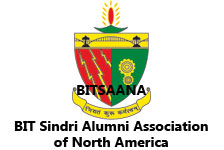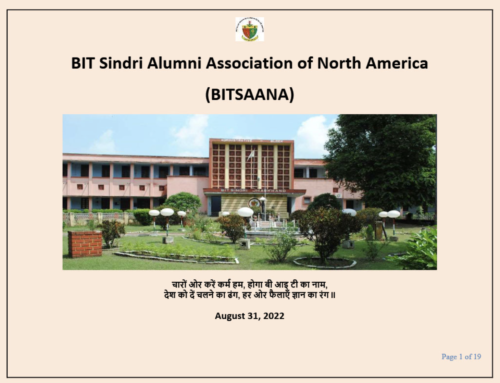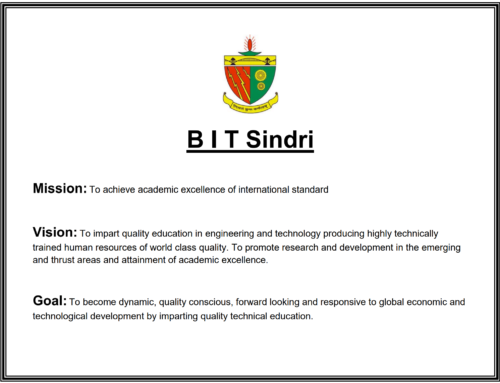Inspring read: Arc of Life of a Product of Rural India with Global AspirationsBy Dr KP SinghDear Fellow BIT Alumni:Brother Hari Agrawal’s merciless persistence has finally overcome my natural reluctance about writing on myself. So here is a brief soliloquy on me and my world as I get close to completing my sixth decade on this earth.The first thirteen years of my life were spent in Barahiya, which lies on the bank of the holy Ganga river roughly 50 miles south- east of Patna. Barahiya is an agricultural hamlet where the prosperity of the local populace, as in most of rural India, was firmly entwined with the vagaries of the annual monsoons and invasion of crop-devouring hordes of insects. The world around my early childhood consisted of god-fearing village folks with a structured social order and an unflinching adherence to the established caste system. Even Muslims, while small in number, seemed to know their place in the social hierarchy. It was a place firmly anchored to the past and armored from the evils of the world by the grand Maharani temple that stood guard for the residents protecting everyone from the whole range of adversities, including even cobra bites. Our dusty hamlet had two libraries, however. Before completing high school, I had read every book they had, including even Soviet and American propaganda pamphlets.Entering the St. avier’s college in 1961 was a transformative experience for me. The college had a well-stocked library and a plurality of faculty (mostly Jesuit priests) of European extraction, who seem to have dedicated their lives to helping others. I resolved to emulate their spirit of charity and sacrifice. Incessantly reading books on all sorts of topics, I was quite mature intellectually when I decided in 1963 to change course from physics (my first attraction) to study engineering.My uncle, Mr. Mahendra Singh, who graduated from Sindri in 1963 was a passionate admirer of the Institute and its leader, Director Deshpandey. Sindri loomed large in our household as a shining shrine-of-knowledge-on-the-hill. I applied only to Sindri; was accepted in the second year of the five-year program along with three or four other stragglers like me who had not entered the college the year before.At Sindri, I learned practical principles and aspects of engineering. Five years later, when I came to the University of Pennsylvania, I learned to become an engineering scientist and mathematician. Both of these institutions have helped shape my professional profile in complementary ways; I owe my achievements, such as they are, to both BIT and Penn.I should also mention Dr. Sharad N. Sinha who was my department head at R.IT. Allahabad where I spent an academic year teaching courses in applied mechanics to the undergraduates. Dr. Sinha, in his own delicate way, steered me away from joining IES or IAS and stoked my natural scientific interests. Fortunately, I decided to abjure the Indian Railway Service (which I had passed) ending my aspirations to become a government official and headed to the US in search of knowledge.Working on a research project at Penn was ideally suited to my bookish and free thinking persona. I thrived at Penn, cranking out a number of technical papers in a short time and starting a lucrative consulting career with the local industry while still a graduate student. It is through my consulting work that I was drawn to peaceful applications of nuclear energy and met my wife, Martha, of 43 years.After a 15-year stint at a small Philadelphia company, having published over 60 technical papers, a text book and a few patents, I was ready, at age 38, to launch my own company. My vision was simple: develop new & better technologies that the industry needs and offer them to the world. The focus was principally on nuclear power. Thirty years later, our company, Holtec International serves clients in some 20 countries and has operation centers on four continents. In the US, Holtec owns two of America’s largest manufacturing plants. In India, we are about to commission a plant in Dahej, Gujarat to manufacture heat exchange equipment. Holtec’s international subsidiaries are: Holtec Asia (Pune), Holtec Africa (Johannesburg), Holtec Arabia (Dubai) and Holtec Ukraine (Kiev). The Company is the world’s dominant provider of systems and equipment to store and transport used nuclear fuel, serving well over 100 nuclear plants around the world.In recent years, I have set my sights a bit higher: our company is developing a small modular reactor which we call SMR-160. It will produce 160 megawatts of electricity and occupy mere four acres of land. It will be “walk away safe;” in other words it will not spew radioactivity no matter how cataclysmic the accident. My goal is build hundreds of SMR-160s in India and thousands around the globe to alleviate the power generation deficiency in the world. At present, it is a work in progress.Increasingly, my principal charitable work, thus far concentrated on the US, will be directed to India, particularly Bihar, which ranks last in many of the metrics of social progress in the nation. I have chosen sanitation as the first societal target. I am fortunate to have several Sindri graduates who are helping me in this campaign. Some three hundred toilets are on way to being commissioned in Bihar; hundreds more are in the offing. We will continue the campaign until the deleterious effect of exposed biological waste is wiped out from the land. After that we will focus on education (illiteracy) and health care.I consider myself fortunate that I can dedicate my life savings to worthy causes that will do maximum good to maximum people. In particular, it will reach those at the very bottom rung of the Indian society. In my humanism-informed Hindu world that is nirvana on earth.









 Total views : 4280
Total views : 4280